Chapter: Psychology: Motivation and Emotion
The Many Facets of Emotion
The Many Facets of Emotion
We
experience emotions such as
happiness, fear, sadness, pride, and anger when we consider our situation
(either real or imagined) to be relevant to our active personal goals (Scherer,
Schorr, & Johnstone, 2001). Some goals that make a situation meaning-ful
are of long-term concern, such as wanting to be liked. Other goals may be more
fleeting, such as hoping to get the last slice of cake, or rooting for the
underdog in a football match.
Whatever
the goal may be, once we’ve evaluated a situation as being personally
rele-vant, three types of changes are evident that, taken together,
characterize emotion. These changes affect our behavior (how we act), our
subjective experience (how we feel), and our physiology (how various systems in
the body are functioning) (Mauss, Levenson, McCarter, Wilhelm, & Gross,
2005). We can identify similar changes in the states we call moods, but psychologists distinguish
emotions from moods in several ways. For one, emotions typically have a clear
object or target (e.g., we are happy about something, or mad at someone); moods
do not. Emotions are also usually briefer than moods, lasting seconds or
minutes rather than hours or days.
BEHAVIORAL ASPECTS OF EMOTION
Some
of our bodily responses to emotion are quite general, such as a broad pattern
of approaching with interest in response to emotionally positive stimuli, or a
general withdrawal in response to emotionally negative stimuli. Perhaps the
most prominent behaviors associated with emotion, however, are our facial
behaviors—our smiles, frowns, laughs, gapes, grimaces, and snarls.
Charles
Darwin hypothesized that our facial expressions of emotion are actually
vestiges of our ancestors’ basic adaptive patterns (1872b). He argued, for
example, that our “anger” face, often expressed by lowered brows, widened eyes,
and open mouth with exposed teeth, reflects the facial movements our ancestors
would have made when biting an opponent. Similarly, our “disgust” face, often
manifested as a wrinkled nose and protruded lower lip and tongue, reflects the
way our ancestors responded to foul odors or spit out foods. (For elaborations,
see Ekman, 1980, 1984; Izard, 1977; Tomkins, 1963.)
In
support of this position, Darwin noted that our facial expressions resemble
many of the displays made by monkeys and apes. Darwin also believed that the
expressions would be identical among humans worldwide, even “those who have
associated but little with Europeans”. This point, too, can be confirmed—for
example, in observations of children born blind, who nonetheless express emotions
using the typical, recog-nizable set of facial expressions despite the fact
that they could not have learned these expressions through imitation (see, for
example, Eibl-Eibesfeldt, 1970; Galati, Scherer, & Ricci-Bitti, 1997;
Goodenough, 1932).
A
different test of this universality claim involves comparisons between cultures
(Russell, 1994; Tracy & Robins, 2008), but only a tiny number of studies
have used the participants most crucial for this test: members of relatively
isolated non-Western cul-tures (Ekman, 1973; Ekman & Oster, 1979; Fridlund,
Ekman, & Oster, 1983; Izard, 1971). Why is this group crucial? If research
participants, no matter where they live, have been exposed to Western movies or
television, their responses might indicate only the impact of these media and
thus provide no proof of the universality claim. Therefore, we need
participants who have not seen reruns of Western soap operas, or Hollywood
movies, or a slew of Western advertising.
In
one of the few studies of this critical group, American actors were
photographed showing expressions that conveyed emotions such as happiness,
sadness, anger, and fear. These photographs were then shown to members of
various modern literate cultures (Swedes, Japanese, Kenyans) and to members of
an isolated nonliterate New Guinea tribe. All participants who saw the photos
were asked to
pick
the emotion label that
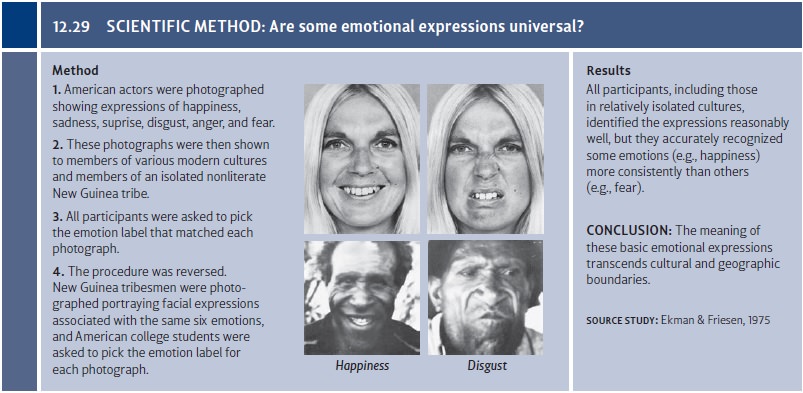
matched
each photograph. In other cases, the procedure was reversed. For example, the
New Guinea tribesmen were photographed portraying the facial expressions that
they considered appropriate to various situations, such as happiness at the
return of a friend, grief at the death of a child, and anger at the start of a
fight (Figure 12.29). American college students then looked at the photographs
and judged which situation the tribesmen in each photo had been asked to convey
(Ekman & Friesen, 1975).
In
these studies, all the participants, including those in relatively isolated
cultures, did reasonably well. They were able to supply the appropriate emotion
label for the pho-tographs, or to describe a situation that might have elicited
the expression shown in the photograph. But they were more successful at
recognizing some expressions than at recognizing others. We highlighted the
biological roots of smiling, and, in
fact, these were, in this study, generally matched with “happy” terms and
situations, with remarkable levels of consistency (Ekman, 1994; Izard, 1994;
see also Russell, 1994). Other emotions, such as disgust, were less well
recognized, but still identified at levels well above chance, suggesting that
the meaning of emotional expressions tran-scends cultural and geographic
boundaries.
Let us note, though, that even though the perception of emotions may be similar in all cultures, the display of emotions is surely not. A widely cited example comes from research in which American and Japanese participants were presented with harrowing surgical films (Figure 12.30). Participants first watched the films privately (i.e., with no one in the room with them), but their facial expressions were recorded by a hidden camera. The facial reactions of Americans and Japanese were virtually identical. But when the participants then watched one of the films again while being interviewed by an experimenter, the results were quite different. In this context, the Japanese showed more positive emotion than the Americans showed (Ekman, 1972; Friesen, 1972). Thus, when in public, participants’ facial expressions were governed by the display rules set by their culture—deeply ingrained conventions, often obeyed without awareness, that govern the facial expressions considered appropriate in particular contexts (Ekman &Friesen, 1969; Ekman, Friesen, & O’Sullivan, 1988).

Of
course, display rules are not limited to a person’s reactions to a gruesome
film. Other studies have extended the analysis of display rules in contexts as
diverse as par- ticipating in sports (H. S. Friedman & Miller-Herringer,
1991) and receiving presents one does not like (P. M. Cole, 1985). Research has
also explored the way in which indi- viduals
differ in their
knowledge of display
rules (Matsumoto, Yoo, & Nakagawa, 2008). These differences include
variation not only from one person to the next, but also
between the genders.
For example, women
in Western cultures
are more likely to express their emotions than men are, particularly
emotions such as sadness (Brody & Hall, 2000; Kring & Gordon, 1998).
EXPERIENTIAL ASPECTS OF EMOTION
Along
with changes in our behavior, emotion also involves changes in how we feel.
Indeed, emotional experience has long been the essence of poetry, literature,
and other forms
of artistic expression
that are all
replete with expressions of
undying love, mortal hatred, and
unquenchable sadness. How can
we study these
fleeting and complex
feelings hidden inside
the mind (Barrett, Mesquita,
Ochsner, & Gross, 2007)? Here, as elsewhere, scientists begin by seeking a
proper classification scheme, and one proposal has focused on defining specific
categories of emotions (see, for example, R. S. Lazarus, 1991). One problem
with this approach, though, lies in
defining exactly what the
categories are. Common language gives few clues. There are over 550 emotion
words in
English (Averill, 1975), and many
more in other
languages that cannot
be translated readily into
English. However, as
Phillip Shaver and
his colleagues have shown, people typically use emotion
words in ways that reveal a relatively small num- ber of “clusters,” which are
defined by words with similar meanings (Shaver, Schwartz, Kirson, &
O’Connor, 1987). As in Figure 12.31, one cluster involves words associated with
love, another involves words associated with joy, and other clusters describe anger,
sadness, and fear. An alternative approach describes emotions in terms of
dimensions rather than categories: “more
this” or “less that” rather than “this type” versus “that type.”There are
various ways in which we might define these dimensions, but one relies simply
on how pleasant or unpleasant the emotion feels, and then how activated
the person feels
when in the
midst of the
emotion (Barrett, 1998; Larsen & Diener, 1992; Russell, 1980, 1983);
these two axes can be used to create a circle within which all the various
inter- mixtures of the dimensions can be described, as in Figure 12.32.
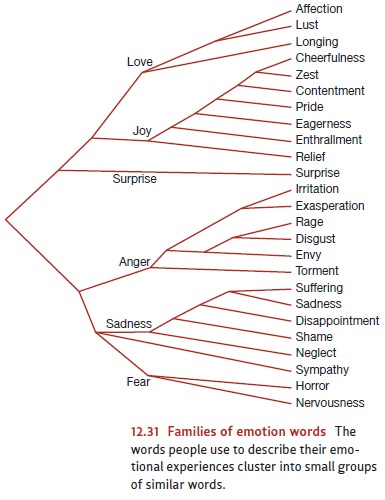
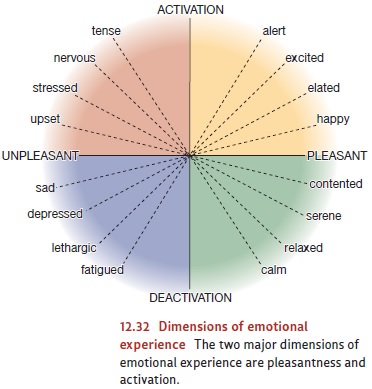
Either
of these categorization schemes can help us figure out how emotions relate to
one another—which are similar, which are sharply distinct. But neither scheme
really tells us what the emotions really feel
like, and so neither scheme answers
questions about individual or cul- tural
differences in emotional
experience. Does your happiness
feel the same as mine? When
someone in Paris feels triste, is
that person’s feeling the same as the
feeling of someone
in London who
feels sad, or
someone in Germany who feels traurig?
For
that matter, how should we think about cultures that have markedly different
terms for describing their emotions? The people who live on the Pacific Island
of Ifalik lack a word for “surprise,” and the Tahitians lack a word for
“sadness.” Likewise, other cultures
have words that
describe common emotions
for which we
have no special
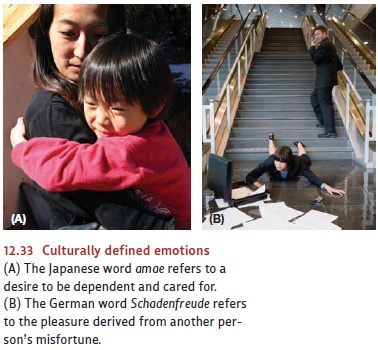
terms.
The Ifaluk sometimes feel an emotion they call fago, which involves a complex mixture of compassion, love, and
sadness experi-enced in relationships in which one person is dependent on the
other (Lutz, 1986, 1988). And the Japanese report a common emotion called amae, which is a desire to be dependent
and cared for (Doi, 1973; Morsbach & Tyler, 1986). The German language
reserves the word Schadenfreude for
the special pleasure derived from another’s misfortune. Do people in these
cultures experience emotions that we do not (Figure 12.33)? Or are emotional
experiences common across cultures, despite the variations in cultures’ labels
for emotional expe-riences? On these difficult questions, the jury is still out.
PHYSIOLOGICAL ASPECTS OF EMOTION
When
we respond emotionally, it is often a whole body affair, and the bodily
reactions associated with different emotions certainly feel different from one another (Levenson, 1994). That is, not only
do the emotions differ in how they feel inside our “head,” but they also seem
to differ in how they feel in the rest of the body. The sick stomach and
wrinkled nose of disgust, for example, feel decidedly different from the
squared shoul-ders and puffed chest of pride. And anger’s hot head and coiled
muscles seem opposite fear’s cold feet and faint heart.
From
a common-sense perspective, it seems that emotions arise when we encounter a
significant stimulus, and this encounter leads to bodily changes that dif-fer
by emotion (Figure 12.34A). Interestingly, this sequence of events was turned
on its head by one of the first emotion theories in the field, namely, William
James’s the-ory that different emotions provoke different patterns of
physiological response (James, 1884). According to the James-Lange theory of emotion (Carl Lange was a European
contemporary of James’s who offered a similar account), the reason emo-tions
feel different from one another subjectively is that we sense the different
phys-iological patterns produced by each emotion. Specifically, this view holds
that emotion begins when we perceive a situation of an appropriate sort—we see
the bear or hear the insult. But our perception of these events is, as James
put it, “purely cog-nitive in form, pale, colorless, destitute of emotional
warmth”. What turns this perception into genuine emotion is our awareness of
the bodily changes produced by the arousing stimuli. These changes might
consist of skeletal movements (running) or visceral reactions (pounding
heartbeat), but only when we detect the biological changes do we move from cold
appraisal to emotional feeling, from mere assessment to genuine affect (Figure
12.34B). Moreover, the claim is that the specific
character of the biological changes is crucial—so that we feel fear because
we are experiencing the pattern of bodily changes associated with fear; we feel
hap-piness because of its pattern of changes in the body, and so on.
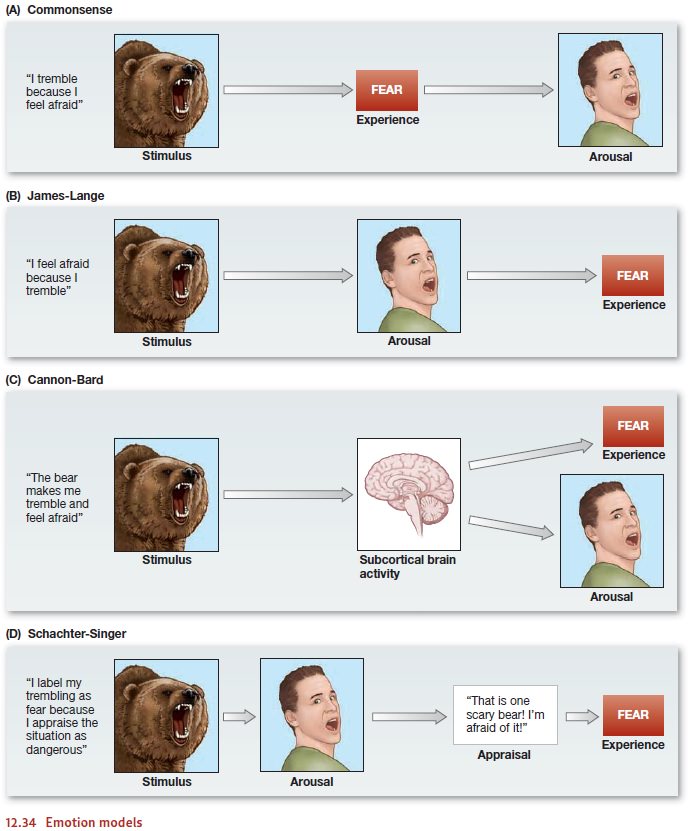
Subsequent theories, however, made quite different predictions about the degree of physiological patterning we should expect in emotion. For example, Walter Cannon, whom we met earlier as a pioneer in the study of the “fight or flight” response, believed that our physiological responses are quite general (W. B. Cannon, 1927). According to the Cannon-Bard theory of emotion (Philip Bard was a contem-porary of Cannon’s who espoused a similar view), it’s not easy to distinguish the bodily changes associated with different emotions, so that the bodily changes associated with anger are actually rather similar to the changes associated with happy excitement (Figure 12.34C).
Cannon’s
view gained support from early studies in which participants received
injections of epinephrine, which triggered broad sympathetic activation with
all its consequences—nervousness, palpitations, flushing, tremors, and sweaty
palms. These biological effects are similar to those that accompany fear and
rage, and so, according to the James-Lange theory, people detecting these
effects in their bodies should experience these emotions. But that was not the
case. Some of the participants who received the injections simply reported the
physical symptoms. Others said they felt “as if ” they were angry or afraid, a
kind of “cold emotion,” not the real thing (Landis & Hunt, 1932; Marañon,
1924). Apparently, the visceral reactions induced by the stimulant were by
themselves not sufficient to produce emotional experience.
Even
so, there is an obvious challenge to the Cannon-Bard theory. If different
emo-tions produce comparable physiological responses, then why do we have the
subjective impression that our bodies are doing quite different things in
different emotional states? This question was addressed by the Schachter-Singer theory of emotion
(Figure 12.34D). According to this theory, behavior and physiology are (as
James proposed) cru-cial for emotional experience. James was wrong, though, in
claiming that the mere per-ception of these bodily changes is sufficient to
produce emotional experience. That is because, in addition, emotion depends on
a person’s judgments about why her
body and physiology have changed (Schachter & Singer, 1962).
In
a classic study supporting this theory, participants were injected with a drug
that they believed was a vitamin supplement but really was the stimulant
epinephrine. After the drug was administered, participants sat in the waiting
room for what they thought was to be a test of their vision. In the waiting
room with them was a confederate of
the experimenter (someone who appeared to be another research participant but
was actu-ally part of the research team). In one condition the confederate
acted irritable, made angry remarks, and eventually stormed out of the room. In
another condition he acted exuberant, throwing paper planes out the window and
playing basketball with balled-up paper. Of course, his behavior was all part
of the experiment; the vision test that the participants were expecting never
took place (Schachter & Singer, 1962). Participants exposed to the euphoric
confederate reported feeling happy, and, to a lesser degree, par-ticipants
exposed to the angry confederate reported that they felt angry. Although this study
has come under criticism (G. D. Marshall & Zimbardo, 1979; Mezzacappa,
Katkin, & Palmer, 1999; Reisenzein, 1983), it remains influential because
it is a reminder that bodily arousal only partially determines the emotion that
is experienced.
Over
the past 50 years, researchers have tried to clarify how the body responds
dur-ing emotional experiences. One of the most interesting conclusions from
this research is that our perceptions of bodily differences among the emotions
may in some cases be illusions, compelling experiences that are not well
grounded in reality (Cacioppo, Berntson, & Klein, 1992). It seems,
therefore, that the various emotions are surprisingly similar if we examine the
body’s response “from the neck down.”
Even
so, the emotions are distinguishable biologically—in the pattern of brainactivation associated with each
emotion. Evidence on this point comes from studiesin the field of affective neuroscience (R . J. Davidson
& Sutton, 1995; Panksepp, 1991, 1998), whose proponents argue that emotions
arise not in one, but in multiple neu-ral circuits. Some brain regions are
activated in virtually all emotions (Murphy, Nimmo-Smith, & Lawrence, 2003;
Phan, Wager, Taylor, & Liberzon, 2002)—for example, the medial prefrontal
cortex. One likely possibility is that this section of the brain plays a
general role in attention and meaning analysis related to emotion. Other brain
regions, however, seem to be related to specific emotions. For example, fear is
often associated with activation of the amygdala, and sadness is often
associ-ated with activation of the cingulate cortex just below the corpus
callosum (although activation in these brain regions is not specific to these
emotions; see Barrett & Wager, 2006). Many researchers are convinced that
brain data like these will eventu-ally allow us to determine the extent to
which different emotions have different phys-iological profiles.
Related Topics